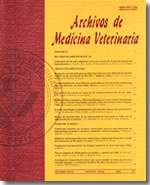Cardiorespiratory effects of the administration of xylazine-morphine in dogs under general anaesthesia with sodium pentobarbital
Main Article Content
Abstract
Cardiorespiratory effects after the administration of morphine, xylazine and the combination of xylazine and morphine were evaluated. Six young and healthy dogs were used for this study. Each animal received four treatments after being anaesthetized with sodium pentobarbital (30 mg/kg), a) 5 ml of saline; b) 0.4 mg/kg of xylazine; c) 0.4 mg/kg of morphine and d) 0.4 mg/kg of morphine plus 0.4 mg/kg of xylazine. The following variables were analyzed for one hour: heart rate, respiratory rate, systolic, diastolic and mean arterial blood pressure. Also, samples for blood gas analysis during times -5, 1, 5, 10, 15 and 30 were taken. Results obtained show that heart rate diminished significantly (P < 0.05) in xylazine and xylazine/morphine groups. Respiratory rate increased in xylazine and xylazine/morphine groups. Blood pressure increased initially in xylazine and xylazine/morphine groups and later diminished until the end of the experiment. Blood gas analysis did not present significant differences among treatments. It can be concluded that the endovenous administration of xylazine, morphine and xylazine and morphine combination produced significant changes (P < 0.05) in heart rate, respiratory rate and blood pressure and did not produce significant changes (P > 0.05) in arterial pH, Pa02, PaC02 and bicarbonate in dogs.

